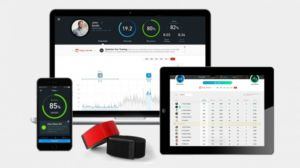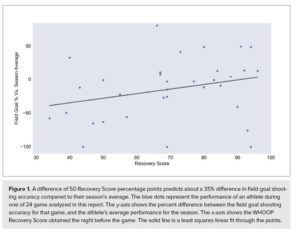Whoop There It Is – Is Wearable Technology the Next Frontier in the NBA?

Can wearable technology help reverse the recent increase in injuries to NBA players?
Over the past two decades, the National Basketball Association (NBA) has seen its popularity explode due in large part to the organization’s growing digital platform. Commissioner Adam Silver has clearly stated his goals for the growth of the NBA, aiming to “go after the NFL’s position as the most popular and profitable sports league”1. As a result, the league has invested in its domestic and international presence through social media, the NBA mobile app, NBATV, and by augmenting its NBA League Pass TV viewer package with streaming Broadband and Mobile offerings. The results speak for themselves as record TV ratings and views/downloads on NBA League Pass, NBA.com, and the NBA app led to the league signing a new television extension with ESPN and Turner that will pay $2.6 billion through the 2024-2025 season, a 180% increase over the current deal2,3.
With a new TV deal in hand, the league would benefit from addressing what many believe is currently its biggest problem, the growing rate of injuries, with another digital solution: wearable technology. Players are the NBA’s greatest assets and over the past five seasons, 217 games were lost to injury, “105 games more than the total in the previous five seasons (2007 – 2011)”4.
Much of this is due to the league’s grueling 82 game schedule that includes multiple sets of games being played on back to back nights, minimizing players’ ability to sleep and recover. The NBA has not entertained shortening the season since this would result in lower ticket and media revenues, necessitating everyone involved to take a pay cut. So how can they reverse this trend? Boston based company Whoop thinks it has the solution.
Whoop is a device worn on the wrist – similar to Fitbit – built to track heart rate, body temperature and body movement, during waking and sleeping hours, to calculate the strain placed on the body and the body’s subsequent recovery5. The product’s five sensors take “lab-quality readings 100 times per second, collecting an incredible 150-megabytes of data on an athlete per day” 6. The company sells the device and accompanying software directly to athletes and teams in order to provide the athlete with information to help them reach their potential.
In addition to the breadth and speed of the data, Whoop differentiates itself by delivering “actionable and behavioral recommendations tailored to the user, depending on the information it receives”5. From Sept 2015 through Jan 2016, Whoop tracked the behavior of 119 NCAA Division I athletes (including basketball). Over the four months, these players increased their average sleep per night by 42 minutes while simultaneously improving their “sleep hygiene” (lower levels of late night caffeine and alcohol)5. Resting heart rate and heart rate variability, “key biomarkers to determine player readiness and recovery,” improved as well5. The result: during this period, the athletes experienced 60% fewer injuries. Similar studies have shown that following the recommendations and improving Whoop’s “Recovery Score” (based on heart rate and variability as well as sleep quality and duration) leads to a significant increase in field goal shooting accuracy7:
As the CEO of Whoop commented, “the best ability is availability. If you have a star player who is injured, fatigued or on the bench, that person isn’t really valuable. This new age of continuously understanding the body will lower injury rates and [drastically] change athletes’ careers”6. The company has received endorsements from star athletes LeBron James and Michael Phelps, offering legitimacy and visibility to Whoop’s value proposition.
Yet NBA rules do not allow these athletes to wear this technology in games, when the data collected is likely the most meaningful. This is due to several reasons, including:
1) Safety – the hardware can cause safety issues if the bracelet accidentally strikes another player
2) Marketing rights – which wearable technology would be deemed acceptable to use by the league?
3) Ownership of data – does the player own their data? If this data can predict an injury, will the front office have access, which could lower the player’s potential contract value?
This technology will be discussed during the 2017 collective bargaining agreement, as the NBA union met with Whoop last April to discuss allowing the technology during games8. These two parties should work together on a partnership in order to promote a better NBA product for the fans, and the NBA can make Whoop an official sponsor of the league. Additionally, the players should have ownership over the data to preserve their negotiating power in contract discussions, sharing with coaches and the team on a voluntary basis. The safety issue remains an interesting topic, and perhaps Whoop can work with the NBA to develop a lighter weight material that could cause less harm.
By embracing wearable technology, the NBA can improve its product and continue to set the standard for digital innovation in sports.
(799 words)
Sources:
1 http://www.delucchiplus.com/nbas-digital-strategy-taking-world/
2 http://www.foxsports.com/nba/story/nba-digital-sees-record-setting-growth-in-regular-season-041416
3 http://deadspin.com/what-the-nbas-insane-new-tv-deal-means-for-the-league-a-1642926274
4 http://www.espn.com/nba/story/_/id/16009898/nba-injury-problem-scheduling-one
5http://www.espn.com/nba/story/_/id/15143072/whoop-future-wearable-technology
6 http://www.wareable.com/sport/wearable-tech-injuries-us-pro-sports
7 https://whoop.com/validation/Case-Study-Recovery-and-Basketball-Performance.pdf
8 http://www.espn.com/nba/story/_/id/15183673/nba-players-union-wearable-tech-company-talk






Very cool post! As a big sports and basketball fan, I am personally partial to the NBA shortening its season because the quality of the product would be much improved (but that’s a conversation for a different day). Regarding the wearables technology, I am a bit confused at what exactly the device is measuring during the game. From your post, it seems as if the technology is tracking sleeping, consumption, and other behaviors outside of the game context. Moreover, most of the issues you mention arise from the potential conflicts of using the device during the game. My point is that much can still be learned from the wristband even if it is not worn in-game to improve player safety, preparation, recovery, etc. and thus improve the quality of the product.
Separate but related, I am wondering if the same technology (assuming you got around the issues surfaced above) can also be used to do more advanced sabermetrics type data collection on players. I know this has been a huge trend in baseball and am wondering if the same can be applied to basketball despite the different dynamics of the individual sports. I’d suspect big data (in terms of stats) would have less of a use-case in basketball vs. baseball given smaller teams and the outsized impact of star players. Would love to chat more on this.
Thanks, Matt. Do you know if the study of the 119 players is statistically significant? It appears to have incredibly high variability with data all over the place.
Also, I wonder why exactly the number of missed games has increased so much over the past several years – there haven’t been any structural changes in the season (same number of games, etc.) and players actually take more rest days in the regular season than in previous decades. I suspect that trainers are just being even more cautious than before.
Regarding Whoop’s plan, I think this type of product is the future of sports and athletic training. I am hopeful that technology will be developed which is small enough to eliminate any safety/sponsorship concerns and players can begin using these types of products during games. It has the potential to protect players and also significantly improve the level of play on the field/court. People will be able to have data supporting changing their technique, form, or speed – no more “traditional” guesswork about what is right and wrong.
Thanks Matt, very interesting trend. I have a similar view to CJ’s in terms of off-court and on-court use of wearable devices. My guess is that with the current health/safety concerns it’d be hard to start implementing things directly league-wide, on the court. If teams can first implement off-the court and have a more solid proof of concept, there’ll be much more buy-in bottom-up to push for an agreement that allows usage on-court.
Thanks Matt! The commentary on when the league will allow the use of this technology during games is interesting — it seems to me that wearable tech is becoming a crowded market, and I wonder if a larger and more established player than Whoop (FitBit or even a new branch of Nike, for instance) could develop something similar and use superior market position to pressure the NBA into rejecting Whoop. Additionally, I could see teams developing some of this analysis in-house as a competitive advantage. That would put Whoop’s value proposition at risk if internal data scientists used generic wearable sensors and developed programs on their own. Great post!
Great post Duarte, you’ve highlighted a big problem and disturbing trend in basketball. The NBA is definitely paying attention, but to this point has been unable to identify solutions that appease all stakeholders (im assuming all players would be in favor of fewer games until it started to trickled down to their own personal bottom line).
Many of the smartest executives and players in the league have resorted to strategic resting of players as a means to mitigate the injury bug. Old-school basketball purists attribute this to millenials being “soft” or “pampered”, but there is something bigger at play here. I have no scientific data to back this up, but I think the tremendous improvements in player training and player performance have actually contributed to more injuries. Men and women now run faster, jump higher, react quicker than ever before. Players who are seven feet tall run around like little point guards and athletes like Russell Westbrook look like they are playing with rocket boosters in their shoes. Ironically, I think this amazing improvement in players’ athletic ability has led to their bodies being put in more precarious situations. When your body is being required to do more and more amazing things, and you are competing against bigger, stronger, faster, opponents, it follows that you see more injuries. In football, as players get continue to evolve and get stronger the hits become more dangerous. Likewise in basketball, as players are jumping higher and contorting their bodies in unimaginable ways, the stress being put on joints is scary.
There is no doubt that a number of factors make you more prone to injury (lack of rest, diet, travel, overuse, etc). And then when you start to combine all of those factors together, the level of risk becomes really high. I believe if players and coaches were able to see visible, quantifiable indicators of this risk – we would have fewer injuries. I certainly wish my coach had this type of data.
I’m so excited to see a post about Whoop! I’ve been following Whoop over the past few months and it seems like what they’re doing is really awesome. In response to Ben’s comment above, I think Whoop and Fitbit target entirely different users. Whoop targets high-performance athletes. The high price point of their devices further signals its intention for serious athletes. Fitbit, on the other hand, targets the lay person (such as myself): someone who cares about their health but isn’t trying to optimize athletic performance. To that end, I don’t think Fitbit poses much of a threat to Whoop despite Fitbit’s market share. A serious athlete isn’t looking to purchase a Fitbit, even if they develop their technology further.
I think one of the great aspects of Whoop is the company’s commitment to maximizing value across the entire lifecycle of the product. In addition to creating a hardware device, Whoop works with athletes and coaches to analyze the data. Their ability to make sense of immense data is a huge value add to users and is a value proposition that many companies are not currently providing. I’d be curious to learn more about how Whoop is using data across users to gain valuable insights into athletic performance.